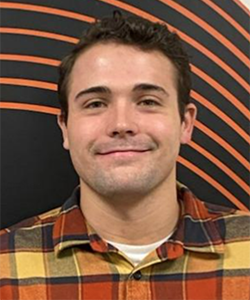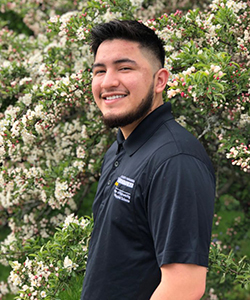Based entirely on the work of four materials engineering students, a Saukville specialty steel manufacturer saved $43,095 last year. And those savings will continue into the future.
Starting in spring 2021, Charter Steel fully implemented an idea proposed by the UWM student team that was tasked in its capstone materials engineering class with developing ways for the company to reduce the cost of a heat-treatment cycle used to produce a particular steel.
The student team consisted of Zachary Breider, Ismael Coello, Davan Siegfried and Hannah Ullberg.

Ben Church, associate professor of materials science and engineering, served as the students’ faculty advisor and Ted Fitzpatrick, a process metallurgist at Charter Steel, was the team’s industry contact.
“The students knocked it out of the park,” Fitzpatrick said. “The entire reason we changed the heat-treatment cycle was because of the work the student group did. They took it above and beyond.”
Now, he said, the company saves $631 every time it runs this cycle.
Environmental benefits and indirect savings are not included in these cost savings. These include less wear and tear on Charter Steel’s annealing furnaces and a lower consumption of processed gas.
Industry members are the heart of student capstones
In their capstone project, the students designed a process that uses less time, less energy and fewer resources to produce the same high-quality steel. In metallurgical terms, Church said, they showed how Charter Steel’s heat-treatment cycle time could be reduced from 10 to four hours while maintaining the critical structure needed for a particular steel.

For Breider — who chose UWM for its internship opportunities and location in a strong manufacturing city — the capstone project’s highlights were experiencing the support of industry members and applying his classroom lessons to the real world.
“It was cool to talk with real-life engineers who showed interest in college students and facilitating their growth,” he said. “And while it’s great and dandy to learn about stuff in a textbook, it doesn’t mean much until you apply it… We had an amazing experience with this project and none of it would have been possible without Dr. Church and Ted Fitzpatrick.”

After graduation, Charter Steel hired Breider full-time as an associate engineer in its materials rotational program, a two- to three-year experience in which new graduates work with various departments in one of the company’s three plants with the goal of accelerating their professional growth and development.
Similarly, the rest of the team graduated from UWM in materials engineering and are on “strong career trajectories,” Church said.
Coello — who emigrated from Mexico at age 6 and is the first in his family to graduate from college — began a doctoral program at Northwestern University. Siegfried began graduate school at UWM while simultaneously starting a career at Metallurgical Associates in Waukesha as a chemical and materials engineer. Ullberg was hired by GE Aviation.
“The student team showed strong creativity and problem-solving skills throughout the project,” Church said, “and Charter Steel was an outstanding partner.”
Metallurgy a “beautiful science”

Today’s metallurgists are creating materials that advance not only the steel industry, but also sustainability, health and medicine, aircraft, and space exploration.
Breider is fully aware that many people misunderstand modern-day metallurgy and other materials sciences.
“I don’t always tell people I’m a metallurgist. They look at me like I’m an alien,” said Breider, who prior to coming to UWM earned a bachelor’s in physics at UW-La Crosse through UW System’s Dual Degree Program in Physics and Engineering. (The five-year program enables students to receive a BS in physics from UW-La Crosse and an engineering major from another university.)
“But it’s a beautiful science that relates to everyday life.”






